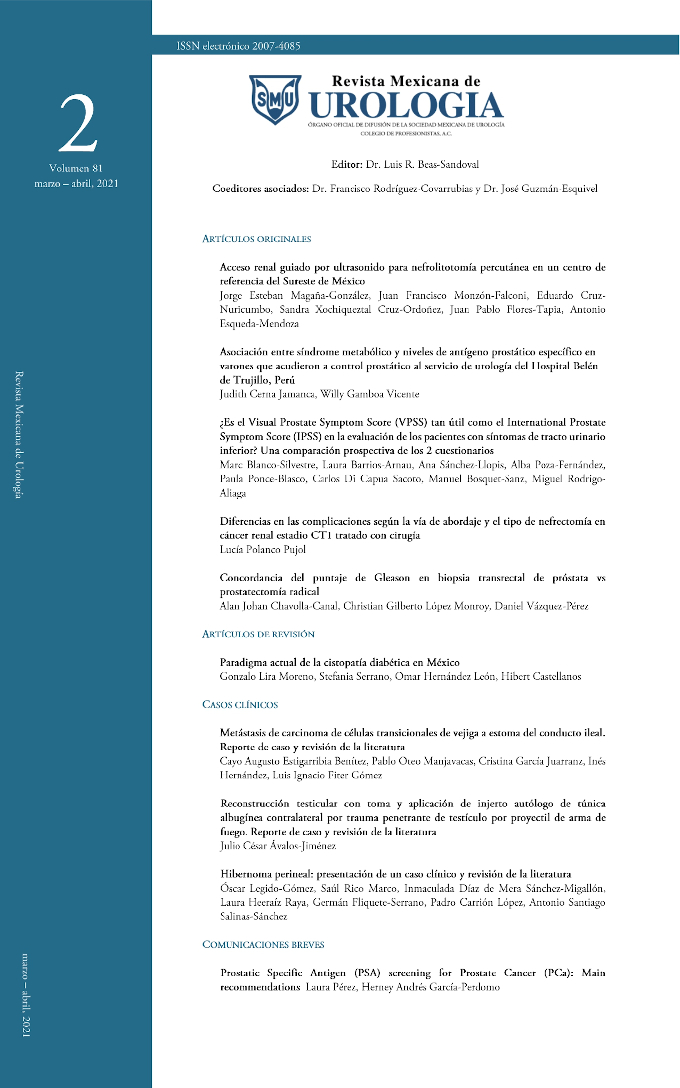Concordance of the Gleason score in transrectal prostate biopsy vs radical prostatectomy
DOI:
https://doi.org/10.48193/revistamexicanadeurologa.v81i2.722Keywords:
Key words: prostate cancer, prostate biopsy, Gleason score, prostatectomy.Abstract
IntroductionThe Gleason scale is a fundamental histopathological diagnostic tool, which directly influences decision-making in the treatment of prostate cancer as well as the prognosis. There are discrepancies in the score obtained through the biopsy and its correlation when obtaining the sample by radical prostatectomy.
ObjectiveTo analyze the concordance of the Gleason scale score obtained by transrectal biopsy and radical prostatectomy.
Patients and MethodsA descriptive cross-sectional study of concordance of diagnostic tests of pathology records of prostate biopsies and radical prostatectomies performed between 2016-2019 was carried out. Cohen's Kappa correlation index was used to determine agreement between variables. Tables and graphs were used to show the results.
ResultsThe Cohen's Kappa concordance index for Gleason in risk group was 0.154 and weighted Kappa was 0.379, implying a poor and weak concordance respectively between the pathological results of the transrectal prostate biopsy with that of the radical prostatectomy. Being understaged in 11.20%, concordant in 43.80% and overstaged in 45%.
ConclusionsWe found a low concordance of the Gleason score in transrectal prostate biopsy and radical prostatectomy, coinciding with some published reports; most of the patients presented an overestimation in our study. This possibility should be taken into consideration when taking a patient for treatment.
Word count: 205 without title.
References
Saman DM, Lemieux AM, Nawal Lutfiyya M, Lipsky MS. A review of the current epidemiology and treatment options for prostate cancer. Dis Mon. 2014 Apr;60(4):150–4. doi: https://doi.org/10.1016/j.disamonth.2014.02.003
Miller KD, Siegel RL, Lin CC, Mariotto AB, Kramer JL, Rowland JH, et al. Cancer treatment and survivorship statistics, 2016. CA Cancer J Clin. 2016 Jul;66(4):271–89. doi: https://doi.org/10.3322/caac.21349
Pardo-Ramos C, Cendales-Duarte Ri. Incidencia, mortalidad y prevalencia de cáncer en Colombia, 2007-2011. 1st ed. Bogotá: Instituto Nacional de Cancerología; 2015.
Attard G, Parker C, Eeles RA, Schröder F, Tomlins SA, Tannock I, et al. Prostate cancer. Lancet. 2016 Jan 2;387(10013):70–82. doi: https://doi.org/10.1016/s0140-6736(14)61947-4
Popiolek M, Rider JR, Andrén O, Andersson S-O, Holmberg L, Adami H-O, et al. Natural history of early, localized prostate cancer: a final report from three decades of follow-up. Eur Urol. 2013 Mar;63(3):428–35. doi: https://doi.org/10.1016/j.eururo.2012.10.002
Andriole GL, Catalona WJ. Prostate carcinoma. Annu Rev Med. 1994;45:351–9. doi: https://doi.org/10.1146/annurev.med.45.1.351
Ilic D, Neuberger MM, Djulbegovic M, Dahm P. Screening for prostate cancer. Cochrane Database Syst Rev. 2013 Jan 31;(1):CD004720. doi: https://doi.org/10.1002/14651858.cd004720.pub3
Washino S, Okochi T, Saito K, Konishi T, Hirai M, Kobayashi Y, et al. Combination of prostate imaging reporting and data system (PI-RADS) score and prostate-specific antigen (PSA) density predicts biopsy outcome in prostate biopsy naïve patients. BJU Int. 2017 Feb;119(2):225–33. doi: 10.1111/bju.13465
Oesterling JE, Jacobsen SJ, Chute CG, Guess HA, Girman CJ, Panser LA, et al. Serum Prostate-Specific Antigen in a Community-Based Population of Healthy Men: Establishment of Age-Specific Reference Ranges. JAMA. 1993 Aug 18;270(7):860–4. doi: 10.1001/jama.1993.03510070082041
Ismail MT, Gomella LG. Transrectal prostate biopsy. Urol Clin North Am. 2013 Nov;40(4):457–72. doi: https://doi.org/10.1016/j.ucl.2013.07.012
Mottet N, Bellmunt J, Bolla M, Briers E, Cumberbatch MG, De Santis M, et al. EAU-ESTRO-SIOG Guidelines on Prostate Cancer. Part 1: Screening, Diagnosis, and Local Treatment with Curative Intent. Eur Urol. 2017 Apr;71(4):618–29. doi: https://doi.org/10.1016/j.eururo.2016.08.003
Chen N, Zhou Q. The evolving Gleason grading system. Chin J Cancer Res. 2016 Feb;28(1):58–64. doi: https://doi.org/10.3978/j.issn.1000-9604.2016.02.04
Cam K, Yucel S, Turkeri L, Akdas A. Accuracy of transrectal ultrasound guided prostate biopsy: histopathological correlation to matched prostatectomy specimens. Int J Urol. 2002 May;9(5):257–60. doi: https://doi.org/10.1046/j.1442-2042.2002.00456.x
Pereira RA, Costa RS, Muglia VF, Silva FF, Lajes JS, Dos Reis RB, et al. Gleason score and tumor laterality in radical prostatectomy and transrectal ultrasound-guided biopsy of the prostate: a comparative study. Asian J Androl. 2015 Oct;17(5):815–20. doi: https://doi.org/10.4103/1008-682x.146970
Cookson Michael S., Fleshner Neil E., Soloway Scott M., Fair William R. Correlation between Gleason Score of Needle Biopsy and Radical Prostatectomy Specimen: Accuracy and Clinical Implications. Journal of Urology. 1997 Feb 1;157(2):559–62. doi: 10.1016/S0022-5347(01)65201-7
Fernandes ET, Sundaram CP, Long R, Soltani M, Ercole CJ. Biopsy Gleason score: how does it correlate with the final pathological diagnosis in prostate cancer? Br J Urol. 1997 Apr;79(4):615–7. doi: https://doi.org/10.1046/j.1464-410x.1997.00126.x
NCCN. NCCN Guidelines for Patients. Prostate Cancer. Plymouth: National Comprehensive Cancer Network; 2018.
Bonkat G, Bartoletti R, Bruyère F, Cai T, Geerlings SE, Köves B, et al. EAU Guidelines: Urological Infections. Amsterdam: European Association of Urology; 2020. 65 p. [accessed 12 May 2021] Available from: https://uroweb.org/guideline/urological-infections/
Matiz JLP, Reyes NJA, Becerra MPS, Almendrales FPD. Evolución de la mortalidad por cáncer de próstata en Colombia: estudio ecológico. Urología Colombiana. 2014 Apr 1;23(1):3–10. doi: https://doi.org/10.1016/S0120-789X(14)50001-9
Stamey TA. Making the most out of six systematic sextant biopsies. Urology. 1995 Jan;45(1):2–12. doi: https://doi.org/10.1016/s0090-4295(95)96168-2
Litwin MS, Tan H-J. The Diagnosis and Treatment of Prostate Cancer: A Review. JAMA. 2017 Jun 27;317(24):2532–42. doi: https://doi.org/10.1001/jama.2017.7248
D’Elia C, Cerruto MA, Cioffi A, Novella G, Cavalleri S, Artibani W. Upgrading and upstaging in prostate cancer: From prostate biopsy to radical prostatectomy. Mol Clin Oncol. 2014 Nov;2(6):1145–9. doi: https://doi.org/10.3892/mco.2014.370
Mills SE, Fowler JE. Gleason histologic grading of prostatic carcinoma. Correlations between biopsy and prostatectomy specimens. Cancer. 1986 Jan 15;57(2):346–9. doi: https://doi.org/10.1002/1097-0142(19860115)57:2%3C346::aid-cncr2820570226%3E3.0.co;2-e
Cohen MS, Hanley RS, Kurteva T, Ruthazer R, Silverman ML, Sorcini A, et al. Comparing the Gleason prostate biopsy and Gleason prostatectomy grading system: the Lahey Clinic Medical Center experience and an international meta-analysis. Eur Urol. 2008 Aug;54(2):371–81. doi: https://doi.org/10.1016/j.eururo.2008.03.049
Epstein JI, Feng Z, Trock BJ, Pierorazio PM. Upgrading and downgrading of prostate cancer from biopsy to radical prostatectomy: incidence and predictive factors using the modified Gleason grading system and factoring in tertiary grades. Eur Urol. 2012;61(5):1019–24. doi: https://doi.org/10.1016/j.eururo.2012.01.050
Kuroiwa K, Shiraishi T, Naito S, Clinicopathological Research Group for Localized Prostate Cancer Investigators. Gleason score correlation between biopsy and prostatectomy specimens and prediction of high-grade Gleason patterns: significance of central pathologic review. Urology. 2011 Feb;77(2):407–11. doi: https://doi.org/10.1016/j.urology.2010.05.030
Moussa AS, Li J, Soriano M, Klein EA, Dong F, Jones JS. Prostate biopsy clinical and pathological variables that predict significant grading changes in patients with intermediate and high grade prostate cancer. BJU Int. 2009 Jan;103(1):43–8. doi: https://doi.org/10.1111/j.1464-410x.2008.08059.x






